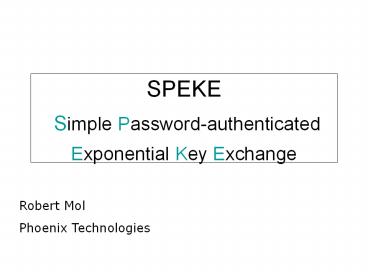SPEKE Simple Password-authenticated Exponential Key Exchange - PowerPoint PPT Presentation
Title:
SPEKE Simple Password-authenticated Exponential Key Exchange
Description:
Title: Phoenix cME Applications Author: Administrator Last modified by: Phoenix Technologies Ltd Created Date: 11/9/2004 12:57:08 AM Document presentation format – PowerPoint PPT presentation
Number of Views:110
Avg rating:3.0/5.0
Title: SPEKE Simple Password-authenticated Exponential Key Exchange
1
SPEKE Simple Password-authenticated Exponential
Key Exchange
Robert Mol Phoenix Technologies
2
Agenda
- Overview
- Industry Challenges
- SPEKE
- Industry implementation
- SPEKE Roadmap
- SPEKE and SACRED
- SPEKE Licensing
3
Overview
- Device Security
- Enterprises and Service Providers cannot achieve
sufficient levels of end point security - Network Security
- Password based protocols and Absence of device
identity magnifies network vulnerability - Content Security
- Enterprise Data security
- Digital content protection and rights management
4
Industry Challenges
- Most protocols are still password based
- Existing solutions like Tokens, smart cards etc
are not cost effective and not very convenient - Phishing and Pharming are now real threats
- A Critical need for mutual authentication
- Identity Theft
- Through user credential harvesting
- 2 Factor Authentication is becoming a necessity
- Most Enterprises still concerned about wireless
data security
5
What is SPEKE?
- SPEKE Simple Password-authenticated Exponential
Key Exchange - A Peer to Peer Zero Knowledge Password Proof
(ZKPP) protocol - A simple password at both ends results in mutual
authentication and a shared session key - Standardized in IEEE 1363 Password-Based
Public-Key Cryptography
6
Benefits of SPEKE
- Mutual Authentication without password exchange
- Resists to man in the middle type attacks
- Prevents dictionary other network attacks
- Not vulnerable to replay
- Resists Phishing via server authentication
- No Password stored on the client
- Very Light Weight component on Client and Server
- Ability to have additional intelligence on the
client - Cross functional across devices, PCs, Mobile
Phones, PDAs etc - No need for additional hardware of Tokens,
Certificates etc - Extremely cost effective for financial
Institution and Consumer applications
7
How SPEKE Protocol Works
Enter password
1
SPEKE server
Algorithm will swap public keys of chosen length
- SPEKE Client
2
Each derives shared password-authenticated key
3
Any Java, J2ME, Emb C client
Output shared key
Output shared key
8
SPEKE-enabled Session
Enter password
Password
SPEKE protocol
- Client
Server
User Provisioning, Service Provisioning,
Enterprise Data etc..
Shared key
Shared key
App server
Encrypted session
App client
Any Java, J2ME, Emb C client
9
SPEKE Industry Implementation
- Entrust
- Entrust True Pass - remotely retrieves users
private key for web-browser PKI-enabled
applications, roaming user application - Funk Software
- 802.1x EAP-SPEKE strong password based
authentication for RADIUS systems - Interlink Networks
- 802.1x EAP-SPEKE strong password based
authentication for RADIUS systems - Research In Motion
- Enterprise Server - provision keys for a generic
BlackBerry device (device enrollment)
10
SPEKE Roadmap
- Current SPEKE SDK
- ANSI C based simple API
- GSS (Generic Security Services) Compliant
- Supports Windows and Unix
- Web Authentication Module
- Plug-ins for Microsoft IE and IIS
- Demo for PC clients ready (06/30/05)
- Java API
- Maximum portability
- New API available for evaluation (07/15/05)
- J2ME Support and API 09/30/2005
- For Mobile Devices
11
SPEKE and SACRED
- SPEKE defined as a one of the authentication
methods for Securely Available Credentials
(SACRED) RFC3760, April 2004 among other strong
password protocols (Section 4.2.1) - SPEKE provides strong mutual authentication of
SACRED client and SACRED server - Shared (derived) strong symmetric key provides
secure communication for credential download
process
12
Licensing Terms
- Available on the IETF website
- https//datatracker.ietf.org/public/ipr_detail_sho
w.cgi?ipr_id587 - To the extent employees of Phoenix Technologies
Ltd. make a contribution which is incorporated in
an adopted IETF Standard - Phoenix will, upon written request, offer
non-exclusive licenses on fair, reasonable and
non-discriminatory terms to prospective licensees
(such terms may include a reciprocal grant back
form the prospective licensees) under such patent
claims for the implementation of such IETF
Standard.
13
For more details please emailkeith_hartley_at_pho
enix.com Thank you































